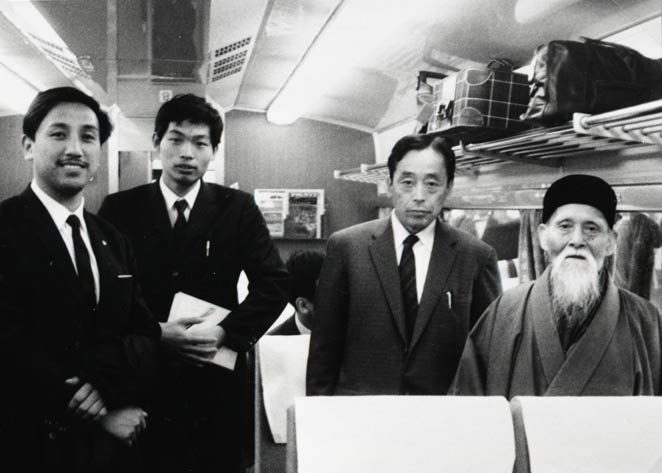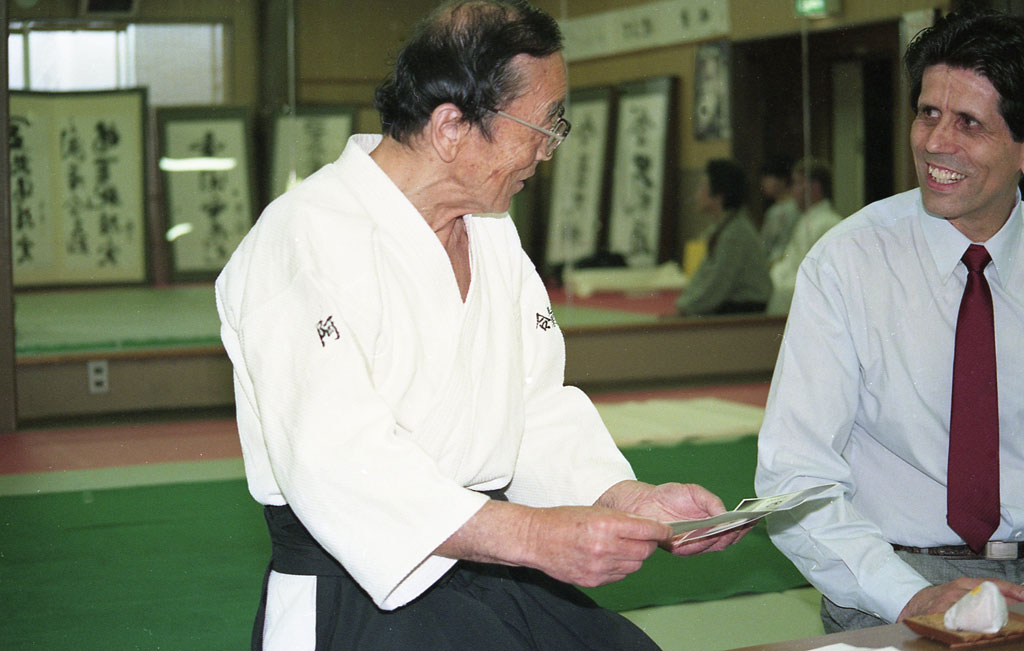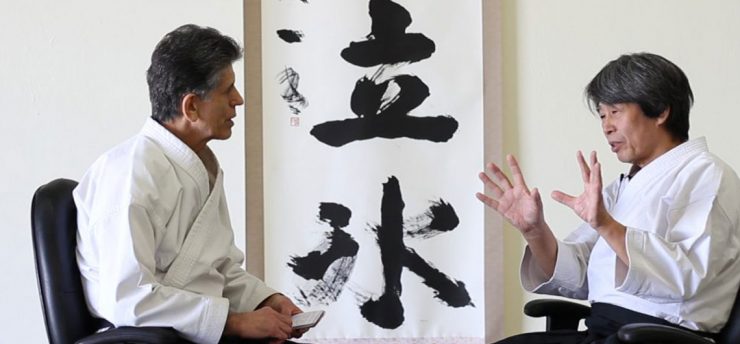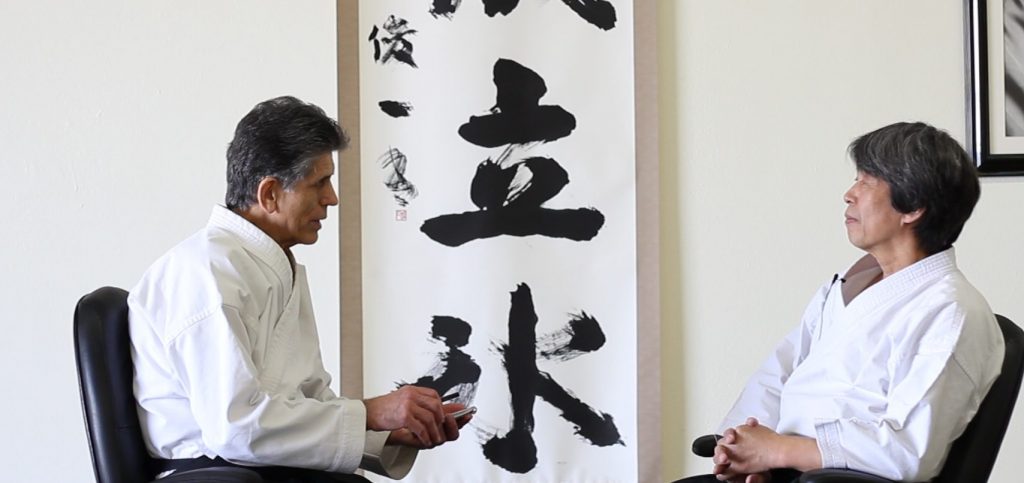This is part one of an interview series with Matsuoka Sensei, conducted by Stan Pranin Sensei of Aikido Journal. In this segment, Matsuoka Sensei talks about his introduction to the art of aikido and his early days of training. Pranin Sensei shares a story about meeting Seagal Sensei at the Iwama Dojo in 1979, highlights the special relationship between the founder and Seiseki Abe Sensei, and has a dialogue with Matsuoka Sensei about the controversial depiction of aikido in the feature films in which he appeared in the late 1980s and early 1990s. Read Part 2 here.
We’re also providing the opportunity to watch a four minute video of Matsuoka Sensei and Seagal Sensei teaching and training in Osaka, Japan in the early 1980s.
Stan Pranin: Sensei, I would like to ask about your introduction to Aikido. I believe it was through your father’s connection with Macrobiotic founder George Ohsawa, and of course Seiseki Abe Sensei, your teacher. Would you talk about when your father first learned of Morihei Ueshiba?
Matsuoka: I was introduced to aikido at a macrobiotics summer camp when I was six or seven years old. I don’t remember exactly. I saw an aikido demonstration there and that was my first experience with the art. Seigo Yamaguchi Sensei led the demo and my father introduced me to him then. I didn’t start learning aikido until I was in high school. However, my motivation and inspiration to start came from that original demo I saw of Yamaguchi Sensei.
Yamaguchi Sensei and my father were followers of macrobiotics under George Ohsawa. At that time, O-Sensei was a good friend of George Ohsawa. Based on that, my father practiced aikido for a short time and was able to meet O-Sensei. My father knew O-Sensei.
As a child how did your father describe O-Sensei to you? Did you feel his enthusiasm?
Yes. I remember several times when he met O-Sensei and afterwards shared his experience with me.
You were very young…
Yes, I was a child at that time. Even my father was young!
Your introduction to Aikido then was with Steven Seagal Sensei, correct?
Actual practice, yes.
Did Seagal Sensei have a connection with Abe Sensei at that time?
Yes, he already did have a connection.

I see. Did Abe Sensei have an influence on the training, or the methods Seagal Sensei would use in his teaching?
Yes, Seagal Sensei was influenced by him. He became especially interested in learning shodo (calligraphy).
When I interviewed Abe Sensei for the first time in 1981, it was in Steven Seagal’s Osaka dojo. He was present in the room when I conducted the interview. So I remember a little bit about the situation there. Abe Sensei is very important in aikido history, not only as one of the earlier students of O-Sensei, but also because of something quite amazing.
O-Sensei became Abe Sensei’s student. O-Sensei was a martial arts master, a master of aikido. Abe Sensei was his student. So we have a very strange situation for the Japanese. But when they were studying calligraphy, the situation was reversed. So Abe Sensei was the master, and O-Sensei, even as an elderly man, became his student.
That’s right.
I know that often in Japan that would be a very uncomfortable situation.
It’s an unusual situation, I believe. Yes, mentor, disciple. It’s a unique situation where people switch back and forth between the roles.
I know you had a great deal of contact with Abe Sensei in the last years of his life. Did he often talk about O-Sensei, and his experiences with him to you?
Yes, we would talk about O-Sensei a lot. He would always talk about O-Sensei as a human being. He never talked about him like he was superhuman. Whenever he talked about O-Sensei he would describe him as a great human being, only in those terms. And that, I remember.
O-Sensei was from the Kansai area, and of course was born in Tanabe. As an older man, O-Sensei didn’t have so many responsibilities, so he liked to travel. I believe he would travel almost every month from Tokyo to Osaka, Tanabe, and Shingu, and sometimes other places too. Wasn’t Abe Sensei’s home the first stop for O-Sensei on those journeys?

Yes, that’s what I heard. I was told that happened between 1952 or 1953 until 1969. And a few months before O-Sensei passed away, almost every month O-Sensei visited and stayed at Abe Sensei’s house for about one week to ten days. And every morning and evening Abe Sensei made him breakfast and dinner. He showed me the menu.
Oh really? Was it a macrobiotic diet?
Basically the macrobiotic diet; brown rice, and miso soup, and vegetables. Then, once a week for dinner he would eat fish. It seemed he was a very strict follower of the macrobiotic diet.
I see.
That’s what Abe Sensei said.
That seems very close to the diet of the Omoto religion. I went to Kameoka (near Kyoto) two or three times for research work, and I stayed overnight. I had meals with them. And they were meals like you’re describing now, very similar to that. So O-Sensei was probably quite comfortable with that sort of diet. You mentioned the last trip to Kansai was in January 1969, so it was maybe less than three months before he passed away. And of course he went to visit other senseis. I suppose he went to Tanabe, and I know he went to Shirahama because there are photographs of him there. He’s really very old, and you can see that he’s in declining health. But the fact that he could make that trip at that late stage of his life is really interesting.
Did Abe Sensei ever describe O-Sensei’s progress as a calligraphy student? I’ll tell you why I ask. In some of the very old pictures from the old Hombu Dojo you can see aikido calligraphy by O-Sensei. But the calligraphy is very simple and basic. Then you see what he was doing toward the end of his life. It was magnificent calligraphy, so obviously he made great progress.
Abe Sensei talked about O-Sensei and training him in calligraphy. But he never talked to me about his progress. Abe Sensei told me that he taught calligraphy technically, and O-Sensei taught him kokyu (breathing). Then Abe Sensei said he learned kokyu, and that’s when Abe Sensei’s own calligraphy really progressed.
Very interesting.
And he never talked about his role as O-Sensei’s teacher. Probably because he’s so humble. O-Sensei is so respected…
Yes, certainly. Could you tell us a little bit about Abe Sensei’s standing in Japan as a calligraphy master? Wasn’t he quite famous, and among the best calligraphers in Japan?
Yes, in that field. For many years he was one of the adjudicators of the Nitten (Japan Fine Arts Exhibition).
Evaluating calligraphy?
Yes, that’s right. Abe Sensei was one of the top masters in calligraphy at that time.
I remember I interviewed Abe Sensei for the second time, probably around 1992 or 1993, something like that. It was in his dojo. We went down to Osaka. And Abe Sensei had hung many calligraphies by O-Sensei on display. And when we went into the dojo there were probably 20 or 25 of them. It was almost like you were walking into a wind or something…it was very powerful, like something touching your body. You could feel O-Sensei’s spirit in the calligraphy.

I had a similar thing happened when I visited the dojo of Katsuyuki Kondo Sensei, the Daito-ryu master. He’s also a collector. And I believe he has the world’s largest collection of calligraphy of Yamaoka Tesshu (1836-1888), the famous Zen master and swordsman. And every year in January, they hang out all the calligraphies in the dojo, to air them out. One time, I went to the dojo and there were rows and rows of hanging scrolls… He had over 100! So I was walking around among many huge scrolls… sometimes drawings of the Buddha, or a warrior face. It feels like you’re walking among living people! Such calligraphic scrolls can be very, very powerful when done by a master. These were fascinating experiences.
Your total training with Steven Seagal Sensei before going to America was about from when to when?
I started in 1976. And I left actually in January 1998. So it was 22 years..
Did you ever go to Iwama in your early years as an aikido student?
No. Unfortunately not.
Do you know the famous O-Sensei film from the Asahi News of 1935? I discovered a copy of it in 1979. Of course, each April 29th they hold the Taisai – the ceremony commemorating aikido Founder Morihei Ueshiba — in Iwama. I believe it was in 1979 that Steven Seagal came up from Osaka, and he brought two or three students along with him.
I see.
And people knew that I had the film, and nobody had seen it. I had a 16mm projector in my house. All day long people were leaving the Taisai grounds and coming over to my house. There were maybe six or seven groups, to watch the movie, so I was showing it all afternoon. Seagal Sensei came with his group.
I missed that.
I see. I spent maybe an hour with him then. It was very interesting. I knew him a little bit back in 1972, because I was invited to the Orange County Aikikai to teach a class. And he was a brown belt then. I called him up for ukemi quite a few times. He had his ponytail, and was real tall and thin, but strong, and had a lot of confidence.
We talked a little bit, so I remembered him. Then I saw him a couple years later, right before his first trip to Japan, which was in the summer of 1974. He came up to me at an aikido demonstration and we talked for a few minutes. He said he was going to Japan, and asked for my advice about various things. So obviously he was going for the first time in the summer of 1974, I believe that’s the truth, so that’s all I will say.
But then when I saw him in 1979 in my home, he was speaking Japanese so fluently, with a Kansai-ben, in an Osaka dialect. And I was so surprised because that’s pretty fast to learn Japanese that well. I was impressed with his language ability. And he was almost like a Japanese teacher scolding his students, and things like that. It left a strong impression. Then a couple years later we did the interview with Abe Sensei at his dojo.
Steven Seagal is very famous in the aikido world, obviously because of his films. And since they are action films, and everyone likes to see exciting scenes, there’s going to be some violence. So I think that audiences who viewed those movies developed an impression of aikido based on what they saw.
As someone who has studied O-Sensei’s life for a long time, I think the viewers’ impression of the art would be somewhat different from mine. You had experience, even as a young man, with people who knew O-Sensei. When you saw these movies, and you were participating in their production on the sets, what did you think of the image of aikido that was being projected?
I understand your question. So the thing is, how do you show aikido on the screen? It has to be a realistic approach. It’s going to be different of course, I understand that. But this is just one expression of aikido. That’s my understanding. Of course, the art could be very soft and peaceful in many different ways off the screen. But how do you do this on the screen, in the movie? You have to have a realistic approach. Some of it looks very brutal, but there are real situations like that.
Yes, there are. Well, it certainly affected the course of aikido history, certainly how the public perceived it. Because probably many more people were introduced to the word “Aikido” through Steven Seagal’s movies than books, or people who came before, like Koichi Tohei Sensei, or some of the other early teachers. So these films have left a strong imprint on the art. I think perhaps a little bit less now, as time has passed. But anyone studying the history of aikido, and its evolution has to take a careful look at that period, and how it was portrayed… how the audiences saw it. I talked to many people at that time who ran aikido dojos, and they said there were many young men who wanted to join, and learn how to be strong, and how to fight well because they saw Steven Seagal on the movie screen.
I see. One point is that he brought aikido to the table to talk about. There was never a dialogue before. I don’t want to say good or bad. But anyway, at least people then have a discussion about aikido. That’s something positive that came out of it.
Yes, I understand. They know the word, they know it’s some kind of Japanese martial art, so that’s the first thing that people need to know.
When did you become independent, you said in 1998?
Yes. That’s when I went back to Japan….
In Part 2 of the interview, Matsuoka Sensei talks about his transition away from Seagal Sensei, his search for new mentors, and how his new discoveries influenced his technical direction and focus.














Add comment